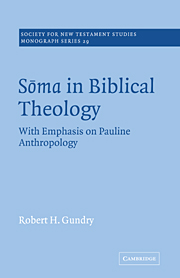Book contents
- Frontmatter
- Contents
- Acknowledgements
- Abbreviations
- PART I FOR AND AGAINST A HOLISTIC DEFINITION OF SŌMA
- PART II SŌMA IN THE FRAMEWORK OF ANTHROPOLOGICAL DUALITY
- PART III THE THEOLOGY OF SŌMA AS PHYSICAL BODY
- 13 The sōma in death and resurrection
- 14 Sōma and the being of man
- 15 Sōma, sin, and salvation
- 16 Sōma, individuality, and solidarity
- 17 Sōma and the Church as the Body of Christ
- Select bibliography
- Index of passages cited
- Index of authors
17 - Sōma and the Church as the Body of Christ
Published online by Cambridge University Press: 14 January 2010
- Frontmatter
- Contents
- Acknowledgements
- Abbreviations
- PART I FOR AND AGAINST A HOLISTIC DEFINITION OF SŌMA
- PART II SŌMA IN THE FRAMEWORK OF ANTHROPOLOGICAL DUALITY
- PART III THE THEOLOGY OF SŌMA AS PHYSICAL BODY
- 13 The sōma in death and resurrection
- 14 Sōma and the being of man
- 15 Sōma, sin, and salvation
- 16 Sōma, individuality, and solidarity
- 17 Sōma and the Church as the Body of Christ
- Select bibliography
- Index of passages cited
- Index of authors
Summary
Robinson's stress on solidarity as the leading motif in sōma leads into the Pauline concept of the Church as the Body of Christ. That concept warrants a whole book. Here we can afford to touch only those aspects which relate most directly to the anthropological use of sōma. Yet it is necessary to do at least that much because a distinction between the anthropological and ecclesiastical uses of sōma is commonly denied nowadays. Once again, by applying what we have learned concerning the use of sōma to current opinions, we shall increase our understanding of the Body of Christ.
As might be expected, the private individualism of Bultmann deeply affects his interpretation of the Church as Christ's Body. He does recognize the communal element, but plays it down as secondary. The main point is not that Christians constitute the Body, but that Christ constitutes the Body. Therefore the Body was there as a cosmic entity before Christians came into being and remains there now above them. The ‘Body of Christ’ indicates, then, primarily the supramundane, transcendental origin of the Church.
A chief difficulty here lies in the failure of Paul to stress, or even to mention, the temporal priority of the Body of Christ over Christians, or its transcendence above the earthly Church. In fact, Paul's comments point the other way. For all we can see, the Body of Christ has no existence apart from the historical Church on earth.
- Type
- Chapter
- Information
- Soma in Biblical TheologyWith Emphasis on Pauline Anthropology, pp. 223 - 244Publisher: Cambridge University PressPrint publication year: 1976



